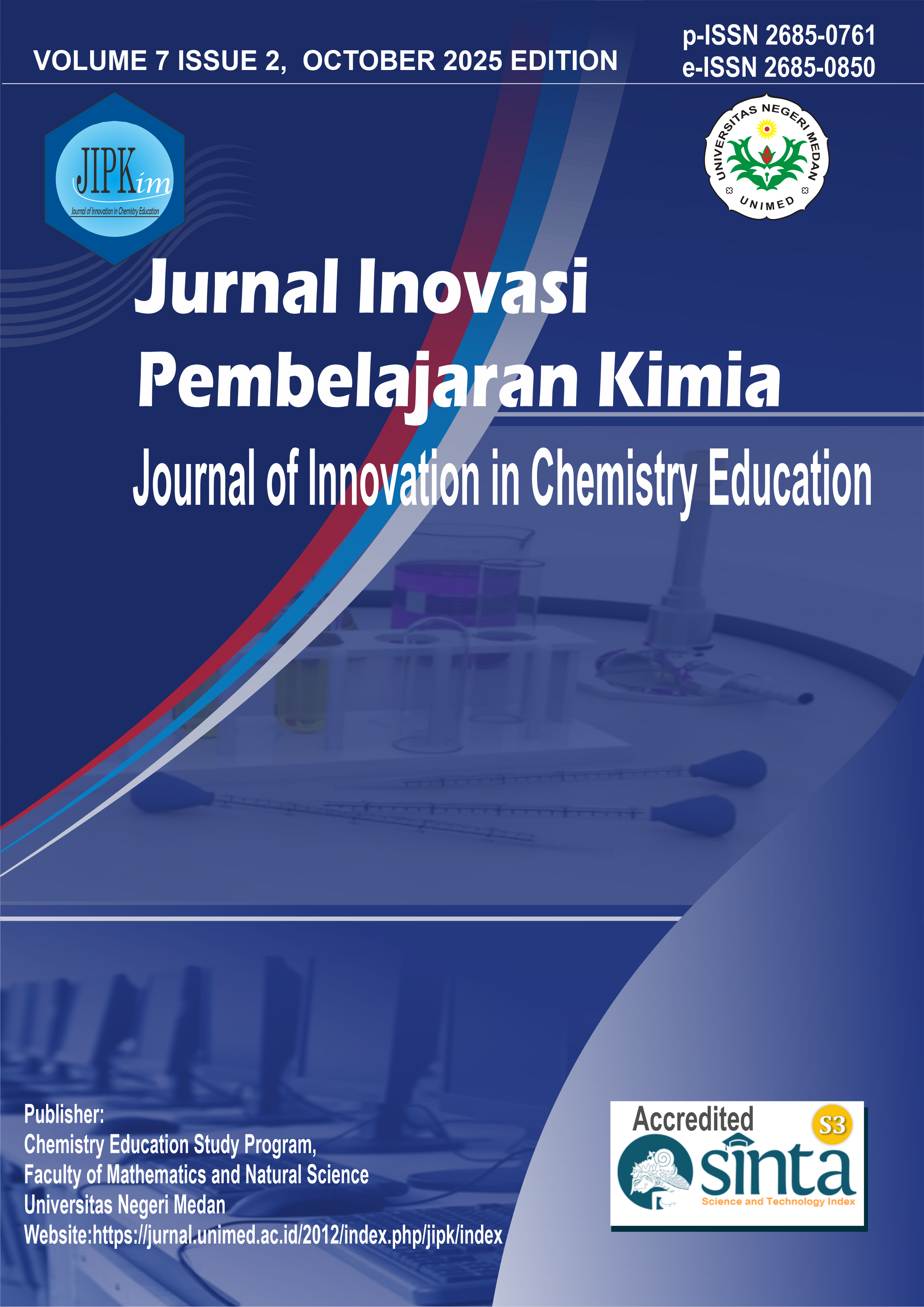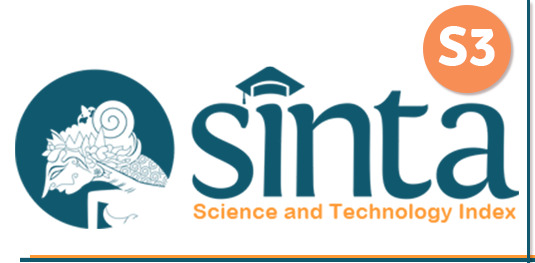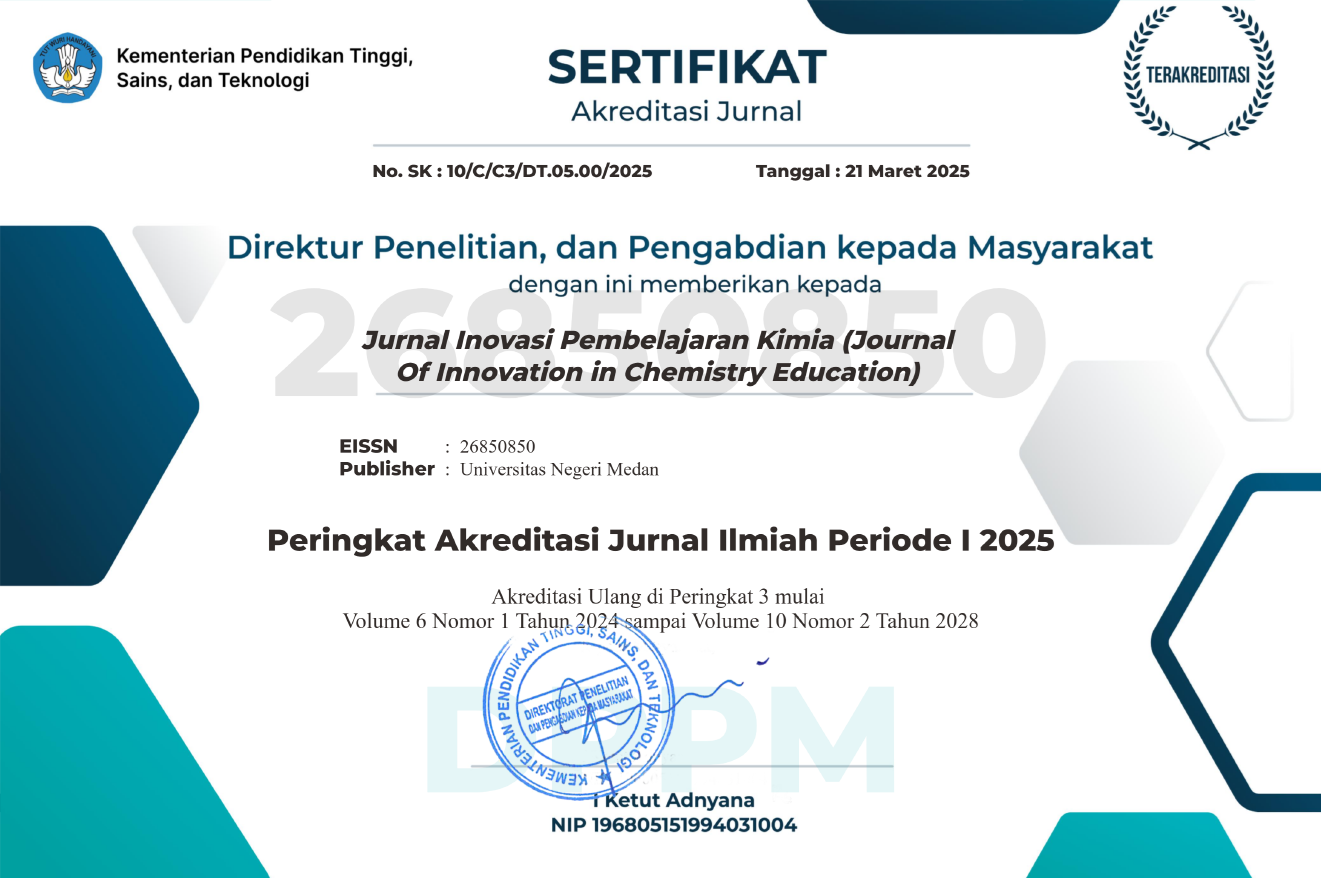Integrating Multiple Representations and Augmented Reality in Maritime Chemistry E-Module Based on IMO 7.04
Keywords:
E-module, maritime chemistry, multiple representations, augmented reality, IMO 7.04Abstract
Chemistry is essential for maritime engineering students, but many concepts are abstract and difficult to understand due to limited resources that integrate macroscopic, microscopic, and symbolic representations. This study aimed to develop and validate a maritime chemistry e-module that combines multiple representations with Augmented Reality (AR) technology, aligned with IMO Model Course 7.04. The research employed the ADDIE development model, consisting of five stages: analysis, design, development, implementation, and evaluation. Data were collected through expert validation sheets and student response questionnaires, and analyzed using percentage analysis. The results showed that the e-module achieved very valid criteria, with average feasibility values of 92.75% for material and 98.09% for media aspects. Student responses indicated high acceptance in terms of appearance, design, ease of use, content comprehension, interactivity, engagement, and perceived benefits, with an overall score of 87.36% classified as very good. In conclusion, the multiple representation-based AR e-module provides maritime engineering students with a practical, contextual, and engaging learning tool, enhancing conceptual understanding in maritime chemistry.References
Abdel-Halim, H. (2020). The effectiveness of using three-dimensional visualization tools to improve students’ understanding of medicinal chemistry and advanced drug design concepts. International Journal of Learning, Teaching and Educational Research, 19(4), 170–187. https://doi.org/10.26803/ijlter.19.4.11
Abdinejad, M., Talaie, B., Qorbani, H. S., & Dalili, S. (2021). Student Perceptions Using Augmented Reality and 3D Visualization Technologies in Chemistry Education. Journal of Science Education and Technology, 30(1), 87–96. https://doi.org/10.1007/s10956-020-09880-2
Agustina, A., Auliah, A., & Hardin, H. (2023). Development of Handout Android-Based Application on Buffer Solution using Discovery Learning Model. Jurnal Inovasi Pembelajaran Kimia, 5(1), 17. https://doi.org/10.24114/jipk.v5i1.44516
Akbar, S. (2013). Instrumen Perangkat Pembelajaran. Rosda.
Anggriawan, B., Effendy, & Budiasih, E. (2017). Kemampuan Spasial dan kaitannya dengan Pemahaman Mahasiswa Terhadap Materi Simetri. Jurnal Pendidikan: Teori, Penelitian, Dan Pengembangan, 2(12), 1612–1619. http://journal.um.ac.id/index.php/jptpp/
Apriani, R., Harun*, A. I., Erlina, E., Sahputra, R., & Ulfah, M. (2021). Pengembangan Modul Berbasis Multipel Representasi dengan Bantuan Teknologi Augmented Reality untuk Membantu Siswa Memahami Konsep Ikatan Kimia. Jurnal IPA & Pembelajaran IPA, 5(4), 305–330. https://doi.org/10.24815/jipi.v5i4.23260
Auliza, O., Rizmahardian, A. ., & Kurniati, T. (2019). Pengaruh Penggunaan Modul Terhadap Kemampuan Multipel Representasi Siswa pada Materi Kelarutan dan Hasil Kali Kelarutan (Ksp) Kelas XI IPA SMA Adisucipto Sungai Raya. Ar-Razi Jurnal Ilmiah, 7(1), 73–81.
Barta, S., Gurrea, R., & Flavián, C. (2023). Using augmented reality to reduce cognitive dissonance and increase purchase intention. Computers in Human Behavior, 140(August 2022). https://doi.org/10.1016/j.chb.2022.107564
Behmke, D., Kerven, D., Lutz, R., Paredes, J., Pennington, R., Brannock, E., Deiters, M., Rose, J., & Stevens, K. (2018). Augmented Reality Chemistry: Transforming 2-D Molecular Representations into Interactive 3-D Structures. Proceedings of the Interdisciplinary STEM Teaching and Learning Conference, 2(1), 3–11. https://doi.org/10.20429/stem.2018.020103
Branch, R. M. (2009). Instructional Design: The ADDIE Approach. In Encyclopedia of Evolutionary Psychological Science. https://doi.org/10. 1007/978-0-387-09506-6
Câmara Olim, S., Nisi, V., & Romão, T. (2024). Augmented reality interactive experiences for multi-level chemistry understanding. International Journal of Child-Computer Interaction, 42(July 2023). https://doi.org/10.1016/j.ijcci.2024.100681
Candido, V., & Cattaneo, A. (2025). Applying cognitive theory of multimedia learning principles to augmented reality and its effects on cognitive load and learning outcomes. Computers in Human Behavior Reports, 18(October 2024), 100678. https://doi.org/10.1016/j.chbr.2025.100678
Cole, M., Wilhelm, J., Vaught, B. M. M., Fish, C., & Fish, H. (2021). The relationship between spatial ability and the conservation of matter in middle school. Education Sciences, 11(1), 1–15. https://doi.org/10.3390/EDUCSCI11010004
Cortés Rodríguez, F., Dal Peraro, M., & Abriata, L. A. (2022). Online tools to easily build virtual molecular models for display in augmented and virtual reality on the web. Journal of Molecular Graphics and Modelling, 114(December 2021). https://doi.org/10.1016/j.jmgm.2022.108164
Damanik, N., Riris, I. D., Sitorus, M., Sihombing, J. L., & Syafriani, D. (2024). The Effect of E-Module on Activity and Learning Outcomes on Electrolyte and Nonelectrolyte Solutions. Jurnal Inovasi Pembelajaran Kimia, 5(2), 174. https://doi.org/10.24114/jipk.v5i2.54922
Djoa, D. D., & Kusumaningtyas, P. (2021). International Journal of Active Learning Design and Feasibility of EXE Learning Media on the Topic of Chemical Bonding. International Journal of Acvtive Learning, 6(2), 76–84. http://journal.unnes.ac.id/nju/index.php/ijal
Elford, D., Lancaster, S. J., & Jones, G. A. (2023). Augmented reality and worked examples: Targeting organic chemistry competence. Computers and Education: X Reality, 2(April), 100021. https://doi.org/10.1016/j.cexr.2023.100021
Handoyo, K. J., Wisnuwardana, C. J., Austen, A., & Permana, F. (2024). Molecule World: Enhancing chemistry education through web-based augmented reality using Assemblr. Procedia Computer Science, 245(C), 1249–1258. https://doi.org/10.1016/j.procs.2024.10.354
Harefa, N., & Sumiyati, S. (2024). Students’ Imaginative Skills to Create a Simple Gamification on Chemistry Material. Jurnal Inovasi Pembelajaran Kimia, 6(1), 53. https://doi.org/10.24114/jipk.v6i1.57325
Hurrahman, M., Erlina*, E., Melati, H. A., Enawaty, E., & Sartika, R. P. (2022). Pengembangan E-Modul Berbasis Multipel Representasi Dengan Bantuan Teknologi Augmented Reality untuk Pembelajaran Materi Bentuk Molekul. Jurnal Pendidikan Sains Indonesia, 10(1), 89–114. https://doi.org/10.24815/jpsi.v10i1.22579
Ibáñez, M., & Carlos, D.-K. (2018). Augmented reality for science learning: A systematic review. In: Computers & Education, 123, 109–123. https://doi.org/10.1016/j.compedu.2018.05.002
Irwansyah, F. S., Yusuf, Y. M., Farida, I., & Ramdhani, M. A. (2018). Augmented Reality (AR) Technology on the Android Operating System in Chemistry Learning. IOP Conference Series: Materials Science and Engineering, 288(1). https://doi.org/10.1088/1757-899X/288/1/012068
Johnstone, A. H. (1997). Chemistry teaching - Science or alchemy? 1996 brasted lecture. Journal of Chemical Education, 74(3), 262–268. https://doi.org/10.1021/ed074p262
Liono, R. A., Amanda, N., Pratiwi, A., & Gunawan, A. A. S. (2021). A Systematic Literature Review: Learning with Visual by the Help of Augmented Reality Helps Students Learn Better. Procedia Computer Science, 179, 144–152. https://doi.org/10.1016/j.procs.2020.12.019
Macariu, C., Iftene, A., & Gîfu, D. (2020). Learn chemistry with augmented reality. Procedia Computer Science, 176, 2133–2142. https://doi.org/10.1016/j.procs.2020.09.250
Mekwong, S., & Chamrat, S. (2021). The Development Learning Activities Using Three Levels of Chemical Representation for Enhance Upper Secondary Students’ Organic Chemistry Concepts. Journal of Physics: Conference Series, 1835(1), 0–9. https://doi.org/10.1088/1742-6596/1835/1/012027
Mindayula, E., & Sutrisno, H. (2021). Multiple representation: The teacher’s perception in chemistry learning. Journal of Physics: Conference Series, 1806(1). https://doi.org/10.1088/1742-6596/1806/1/012194
Mumpuni, A., & Nurbaeti, R. . (2019). Analisa Faktor Yang Mempengaruhi Minat Baca Mahasiswa PGSD. Jurnal Dimensi, 3(2), 123–132. https://doi.org/10.33373/dms.v11i2.4060
Nechypurenko, P. P., Starova, T. V., Selivanova, T. V., Tomilina, A. O., & Uchitel, A. D. (2018). Use of augmented reality in chemistry education. CEUR Workshop Proceedings, 2257(December 2018), 15–23. https://doi.org/10.31812/pedag.v51i0.3650
Nur Fitri Fadhilah, & Haqqi Annazili Nasution. (2025). Development of Chemistry E-Modules Based on Augmented Reality Technology on Hydrocarbon Material. Jurnal Inovasi Pembelajaran Kimia, 7(1), 124–133. https://doi.org/10.24114/jipk.v7i1.67921
Nurdiyanti. (2017). Pengembangan Buku Ajar dan Augmented Reality pada Konsep Sistem Ekskresi di Sekolah Menengah Atas. Universitas Negeri Makassar.
Organization, I. M. (2014). IMO Model Course 7.04 Officer in Charge of an Engineering Watch.
Pardosi, I., & Situmorang, M. (2024). Implementation PhET Virtual Laboratory-Based Learning Media to Increase Learning Outcomes on Teaching of Acid-Base. Jurnal Inovasi Pembelajaran Kimia, 6(1), 111. https://doi.org/10.24114/jipk.v6i1.57330
Puspitarini, Y. D., & Hanif, M. (2019). Using Learning Media to Increase Learning Motivation in Elementary School. Anatolian Journal of Education, 4(2), 53–60. https://doi.org/10.29333/aje.2019.426a
Putra, D. W. ., Windyana, P., Syahrani, A., & Mandarani, P. (2020). Pengaruh Jarak Deteksi Marker Terhadap Waktu Delay pada Augmented Reality. Jurnal Edik Informatika, 7(1), 17–22. http://dx.doi.org/10.22202/ei.2020.v7i1.4257
Radu, I., Yuan, J., Huang, X., & Schneider, B. (2023). Charting opportunities and guidelines for augmented reality in makerspaces through prototyping and co-design research. Computers and Education: X Reality, 2(January), 100008. https://doi.org/10.1016/j.cexr.2023.100008
Ramadhan, S., Mardapi, D., Prasetyo, Z. K., & Utomo, H. B. (2019). The development of an instrument to measure the higher order thinking skill in physics. European Journal of Educational Research, 8(3), 743–751. https://doi.org/10.12973/eu-jer.8.3.743
Ratna Ningsih, I. N. I. S. R. (2020). The Use of Augmented Reality Cards to Improve Science Learning Outcomes About the Effect of Force on The Shape and Motion of Objects. Journal of Education Technology, 4(3), 228. https://doi.org/10.23887/jet.v4i3.28528
Rebello, C. M., Deiró, G. F., Knuutila, H. K., Moreira, L. C. de S., & Nogueira, I. B. R. (2024). Augmented reality for chemical engineering education. Education for Chemical Engineers, 47(April), 30–44. https://doi.org/10.1016/j.ece.2024.04.001
Rizki, I. A., Mirsa, F. R., Islamiyah, A. N., Saputri, A. D., Ramadani, R., & Habibbulloh, M. (2025). Ethnoscience-enhanced physics virtual simulation and augmented reality with inquiry learning: Impact on students’ creativity and motivation. Thinking Skills and Creativity, 57(February), 101846. https://doi.org/10.1016/j.tsc.2025.101846
Safitri, N. Y., & Dwiningsih, K. (2020). Development Interactive Multimedia Using 3D Virtual Modelling on Intermolecular Forces Matter. International Journal of Chemistry Education Research, 4(April), 17–25. https://doi.org/10.20885/ijcer.vol4.iss1.art3
San, S. M., Widoretno, S., Ariyanto, J., Sajidan, & Dwiastuti, S. (2020). Increase the hierarchy concept map score through the modification in the 2nd stage of problem-based learning. Journal of Physics: Conference Series, 1567(2), 0–6. https://doi.org/10.1088/1742-6596/1567/2/022057
Scaravetti, D., & Doroszewski, D. (2019). Augmented reality experiment in higher education, for complex system appropriation in mechanical design. Procedia CIRP, 84(March), 197–202. https://doi.org/10.1016/j.procir.2019.04.284
Sianturi, I. N., & Abdurrahman. (2019). Exploring Multiple Representation Preference to Develop Students Misconception Inventory in Measuring of Students Science Conception Awareness. Journal of Physics: Conference Series, 1233(1). https://doi.org/10.1088/1742-6596/1233/1/012039
Silva, M., Bermúdez, K., & Caro, K. (2023). Effect of an augmented reality app on academic achievement, motivation, and technology acceptance of university students of a chemistry course. Computers and Education: X Reality, 2(April), 1–9. https://doi.org/10.1016/j.cexr.2023.100022
Smith, C., & Friel, C. J. (2021). Development and use of augmented reality models to teach medicinal chemistry. Currents in Pharmacy Teaching and Learning, 13(8), 1010–1017. https://doi.org/10.1016/j.cptl.2021.06.008
Stojanovska, M., M. Petruševski, V., & Šoptrajanov, B. (2017). Study of the Use of the Three Levels of Thinking and Representation. Contributions, Section of Natural, Mathematical and Biotechnical Sciences, 35(1), 37–46. https://doi.org/10.20903/csnmbs.masa.2014.35.1.52
Weng, C., Otanga, S., Christianto, S. M., & Chu, R. J. C. (2019). Enhancing students’ biology learning by using augmented reality as a learning supplement. Journal of Educational Computing Research, 58(4), 1–24. https://doi.org/10.1177/0735633119884213
Wiyarsi, A., Sutrisno, H., & Rohaeti, E. (2018). The effect of multiple representation approach on students’ creative thinking skills: A case of ‘Rate of Reaction’ topic. Journal of Physics: Conference Series, 1097(1). https://doi.org/10.1088/1742-6596/1097/1/012054
Yuni, R., & Afriadi, R. (2020). Pengembangan Modul Pembelajaran Kondisional Untuk Belajar Dari Rumah (Bdr). Jurnal Handayani, 11(2), 144. https://doi.org/10.24114/jh.v11i2.22101
Zhou, X., Tang, L., Lin, D., & Han, W. (2020). Virtual & augmented reality for biological microscope in experiment education. Virtual Reality and Intelligent Hardware, 2(4), 316–329. https://doi.org/10.1016/j.vrih.2020.07.004













